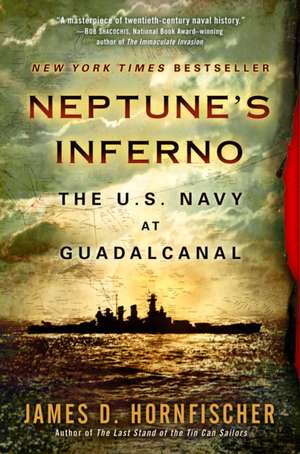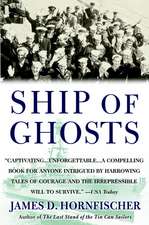Neptune's Inferno: The U.S. Navy at Guadalcanal
Autor James D. Hornfischeren Limba Engleză Paperback – 14 mar 2012
"A literary tour de force that is destined to become one of the . . . definitive works about the battle for Guadalcanal . . . [James D.] Hornfischer deftly captures the essence of the most pivotal naval campaign of the Pacific war."-San Antonio Express-News The Battle of Guadalcanal has long been heralded as a Marine victory. Now, with his powerful portrait of the Navy's sacrifice, James D. Hornfischer tells for the first time the full story of the men who fought in destroyers, cruisers, and battleships in the narrow, deadly waters of "Ironbottom Sound." Here, in stunning cinematic detail, are the seven major naval actions that began in August 1942, a time when the war seemed unwinnable and America fought on a shoestring, with the outcome always in doubt. Working from new interviews with survivors, unpublished eyewitness accounts, and newly available documents, Hornfischer paints a vivid picture of the officers and enlisted men who opposed the Japanese in America's hour of need. The first major work on this subject in almost two decades, Neptune's Inferno does what all great battle narratives do: It tells the gripping human stories behind the momentous events and critical decisions that altered the course of history and shaped so many lives. Praise for Neptune's Inferno "Vivid and engaging . . . extremely readable, comprehensive and thoroughly researched."-Ronald Spector, The Wall Street Journal "Superlative storytelling . . . the masterwork on the long-neglected topic of World War II's surface ship combat."-Richard B. Frank, World War II "The author's two previous World War II books . . . thrust him into the major leagues of American military history writers. Neptune's Inferno is solid proof he deserves to be there."-The Dallas Morning News "Outstanding . . . The author's narrative gifts and excellent choice of detail give an almost Homeric quality to the men who met on the sea in steel titans."-Booklist (starred review) "Brilliant . . . a compelling narrative of naval combat . . . simply superb."-The Washington Times
Preț: 140.66 lei
Nou
26.92€ • 28.03$ • 22.75£
Carte în stoc
Livrare din stoc 28 ianuarie
Specificații
ISBN-10: 0553385127
Pagini: 516
Ilustrații: 2 16-page b&w inserts, 9 maps
Dimensiuni: 155 x 233 x 31 mm
Greutate: 0.59 kg
Editura: Bantam
Notă biografică
Extras
Trip Wire
Two years before the war began, an old spanish priest in a Filipino village said to an American journalist, "The Pacific: Of itself it may not be eternity. Yet certainly you can find in it the scale, the pattern of the coming days of man. The Mediterranean was the sea of destiny of the Ancient World; the Atlantic, of what you call the Old World. I have thought much about this, and I believe the Pacific holds the destiny of your New World. Men now living will see the shape of the future rising from its waters."
The vessel of that ocean held more than half the water on earth, its expanse larger than all the landmasses of the world. Its beauty was elemental, its time of a meter and its distances of a magnitude that Americans could only begin to apprehend from the California, Oregon, and Washington coasts. It was essential and different and compelling and important, whether one measured it by grid coordinates, assessed it by geopolitics and national interests, or sought its prospects above the clouds. And when war came, it was plain to see that the shape of the future, whatever it was to be, was emerging from that trackless basin of brine.
Whose future it would be remained unsettled in the first summer of the war. The forces of distant nations, roaming over it, had clashed briefly but had not yet collided in a way that would test their wills and turn history. That collision was soon to take place, and it would happen, first and seriously and in earnest, on an island called Guadalcanal.
It was a single radio transmission, a clandestine report originating from that island's interior wilderness, that set the powerful wheels turning. The news that reached U.S. Navy headquarters in Washington on July 6, 1942, was routine on its face: The enemy had arrived, was building an airstrip. This was not staggering news at a time when Japanese conquest had been proceeding smoothly along almost every axis of movement in the Asian theater. Nonetheless, this broadcast, sent from a modest teleradio transmitter in a South Pacific jungle to Townsville, Australia, found an attentive audience in the American capital.
The Cambridge-educated agent of the British crown who had sent it, Martin Clemens, had until recently been the administrator of Guadalcanal. When it became clear, in February, that the Japanese were coming, there had been a general evacuation of the civilian populace. Clemens stayed behind. Living off the land near the village of Aola, the site of the old district headquarters, the Australian, tall and athletic, took what he needed from gardens and livestock, depending on native sympathies for everything. Thus sustained, he launched a second career as a covert agent and a "coastwatcher," part of a network of similarly situated men all through the Solomons.
Holed up at his station, he had radioed word to Townsville on May 3 that Japanese troops had landed on the smaller island of Tulagi across the sound. A month later, he reported that they were on Guadalcanal's northern shore, building a wharf.
Then from his jungle hide, Clemens saw a twelve-ship convoy standing on the horizon. Landing on the beach that day came more than two thousand Japanese construction workers, four hundred infantry, and several boatloads of equipment--heavy tractors, road rollers, trucks, and generators. Clearly their purpose was some sort of construction project. Having detected Clemens's teleradio transmissions to Australia, the enemy sent their scouts into the jungle to find him. As the pressure on Clemens and his fellow Australian spies increased, he kept on the move to elude them, aided by a cadre of native scouts, formidable and capable men. The stress of avoiding enemy reconnaissance planes overhead worked on him. He read Shakespeare to settle his mind. "If I lose control everything will be lost," he wrote in his diary on July 23. His radio batteries were nearly depleted, and his food stores thin, when he spotted a gravel-and-clay airstrip under construction on the island's north-coast plantation plain and reported it from his hide in a hillside mining claim. He had sent many reports. This one would bring salvation.
When the commander in chief of the U.S. Fleet, Admiral Ernest J. King, learned from radio intercepts that Japan had sent airfield construction crews to Guadalcanal, a new impetus to action came. He and the Army's chief of staff, General George Marshall, had already struck a compromise that would send U.S. forces into the South Pacific with the ultimate objective of seizing Rabaul, the great Japanese base in New Britain. The first phase of that operation would be the seizure of Tulagi and adjacent positions. With the arrival of the news of Japanese activity on Guadalcanal across the sound, however, the design of America's first major offensive of the war was redrawn, set to begin on Martin Clemens's forlorn hideaway.
It was as if Japan's expansion southeast from Rabaul had struck a hidden trip wire--the lines drawn on Navy charts tracing the paths of sea communication across the South Pacific to Australia. As anyone could see by taking a compass and drawing a 250-mile radius centered on Guadalcanal's air_strip, it would, when operational, enable Japanese planes to threaten the sea-lanes to Australia, whose protection was long one of the Navy's core missions. Construction of the airfield might have been low-order business for Japanese forces spread thinly along a multi-continental oceanic perimeter, but its discovery would draw the fleet straight to Guadalcanal.
The island, shaped like Jamaica, with about half its area, had come to the attention of Westerners long ago. Explorers from the old Spanish priest's homeland, passing through the Solomons in 1568, named it after a town in Andalusia, sixty miles north of Seville. When Captain James Cook arrived 220 years later, he claimed the Solomons for Great Britain, which hung on for another 154 years, until Japanese troops landed. The novelist Jack London visited near the turn of the century and doubted his heart was cold enough to banish his worst enemies to a place so dire, where "the air is saturated with a poison that bites into every pore . . . and that many strong men who escape dying there return as wrecks to their own countries."
A mountain range ran its entire length like a spine, with summits as high as eighty-three hundred feet. On the southern coast, the mountains fell steeply into the sea, making that shoreline a barrier to trade and to war. The north coast's tropical plain was more inviting. Cut through with rivers and forest growth, it was well suited to agriculture--and airfields. The narrow northern beach, guarded by palms and ironwoods and covered in kunai grass, stretched for miles, overlooked by scattered coral ridges, some of them five hundred feet high.
From the British government outpost at Aola to the small Catholic missions in the west, the human settlements were small and prehistoric. The climate, the insects, and the rampant disease made the place hard to tolerate. A coconut plantation owned by Lever Brothers, the world's largest, drew its employees from the nine thousand resident Melanesians, traditionally divided by culture but now joined imperfectly by one of the few useful things that Britain had brought there: pidgin English.
The U.S. Navy would not have greatly concerned itself with the Solomons, with a census roughly that of Trenton and a population density of ten people per square mile, if not for the accident of its geography, astride the sea-lanes to Australia. Tulagi, the British administrative capital, had the best anchorage for hundreds of miles around. On that rocky volcanic islet nestled against Florida Island, huge trees and mangrove swamps lined the shore where they hadn't been cut back to accommodate the trappings of Western empire: a golf course, a commissioner's office, a bishop's residence, a government hospital, a police barracks, a cricket club, and a bar.
Guadalcanal lay about twenty miles south of Tulagi. It marked the southern end of a broken and irregular inter-island corridor that meandered northwest between two parallel columns of islands and dead-ended, about 375 miles later, into the island of Bougainville. As the principal route of Japanese reinforcement into Guadalcanal, this watery path through New Georgia Sound would acquire an outsized strategic importance. It would be nicknamed the Slot.
admiral chester w. nimitz, fifty-six, the grandson of a German hotelier from the Hill Country of central Texas, was born to a rare style of leadership: gentle but exacting, gracious but hard and fearless, like a mailed fist in a satin glove. There was no ruthlessness in him unless one counted as ruthless his willingness to burden the people he relied on with his complete and unfaltering trust. That burden fell heavily upon the men who worked for him, but one of his gifts was an ability to turn the burden into a source of inspiration and uplift for those who shouldered it. The U.S. Navy never needed a leader of his kind more badly than in the months following the treachery of December 7, shortly after which he took command of the Pacific Fleet.
Nimitz's will was ferocious, but held inward and insulated by a kindly temperament that made his ascent to high command a surprise to connoisseurs of four-star ambition. His intensity was apparent only in his close physical proximity, where the heat from his eyes, it was said, could be felt on the skin. Nimitz was an unusually effective organization man, stoic and controlled but demanding. Ascending to theater command had never been his ambition, for ambitions, he felt, were meant not for personal gain but to pursue common goals within the established order of a group. In 1941, a year before circumstances forced him to accept it, he had turned down the appointment to become commander in chief, Pacific Fleet (CINCPAC). He had done so out of respect for the system, unwilling to vault past the twenty-eight officers who were senior to him. But after the attack on Pearl Harbor his own commander in chief gave him no choice. Franklin D. Roosevelt plucked Nimitz from his post as the Navy's personnel boss and installed him as leader of the most important naval theater in the world. It was a call to duty that allowed no humble refusals. The president told Navy Secretary Frank Knox, "Tell Nimitz to get the hell out to Pearl and stay there till the war is won." The Pacific war would be America's war. Running it would be a lonely charge. A commentator for Collier's magazine would call the Pacific "an unshared front where America's production, her strategy, her skill and valor must stand the acid test alone. . . . Our national feeling with regard to the Pacific burns with a purer flame. We seem to realize that here is not a war rooted in the age-old hatreds and grudges of Europe. Here, rather, is a war to resolve new and inescapable problems." Those problems would be many and their owner, as far as the Navy cared, was Chester Nimitz.
Nimitz's chief of staff, Raymond A. Spruance, would call him "one of the few people I know who never knew what it meant to be afraid of anything." His duties were of the kind that exhausted the conscientious and the caring. After the Oahu attack, he had to sort out its myriad administrative consequences--three thousand letters to send to bereaved families, untold gatherings of men and machines to reassign to useful tasks. As head of the Bureau of Navigation, which handled personnel issues, he had tendered the applications of the ambitious and the vengeful, including more than one U.S. congressman who phoned him after December 7 to lobby for an enlistment. Overwhelmed and sleepless, Nimitz was said to have told his congressional supplicants, "Go back and vote us appropriations. We're going to need them."
On December 19, Nimitz left his office on Constitution Avenue and returned to his apartment on Q Street to share the news of his appointment with his wife. Sensing his reluctance, Catherine reminded him, "You always wanted to command the Pacific Fleet. You always thought that would be the height of glory."
"Darling," replied Nimitz, "the fleet's at the bottom of the sea. Nobody must know that here, but I've got to tell you."
He had grown to dread the assignment, and would have even if it didn't entail commanding a wounded squadron, the battleships of Task Force 1, whose lifeblood, their oil, still seeped in rainbow ribbons from their broken hulls off Ford Island. He would have dreaded it because he knew his promotion was a zero-sum transaction; it required the demotion of someone else, and that person happened to be one of Nimitz's closest friends, Husband E. Kimmel. Pearl Harbor had burned on Kimmel's watch, so Kimmel paid the price. If the charge of negligence failed by the standard of a trial court, and if the proceeding that tarred him was driven more by political expediency than by examination of a fuller truth concerning who had what level of warning and when, it was also the verdict that the code of naval leadership required. A captain was expected to go down with his ship; why not an admiral with his base? The principle was clean, simple, and predictable in operation. It was the Navy way.
Within a few short years America's fleet would be more powerful and capable than any before it. The same could be said of Nimitz's superior in Washington, the leading U.S. naval commander of the day. Though he worked in guarded isolation, giving subordinates little direct access, no admiral had ever wielded the same degree of personal influence on wartime policy as Ernest J. King. As the commander in chief of the U.S. Fleet (COMINCH) and chief of naval operations (CNO), he was preeminent in both planning and command. His influence and his formidable personal nature made him a figure to be reckoned with within the Navy Department bureaucracy. Ensconced on the front corridor of the fourth floor of "Main Navy," the large headquarters building on Constitution Avenue, he was memorably unlike Nimitz. "Subconsciously he sought to be omnipotent and infallible," his biographer wrote. "There were few men whom he regarded as his equal as to brains; he would acknowledge no mind as superior to his own." He was abrupt and unyielding, visibly intolerant of those he deemed fools. Though his first reflex was always to reject even the best advice, he did once concede to a staffer, "Sometimes my bark is worse than my bite."
King penalized caution wherever it surfaced. In March, he was outraged to learn that one of his admirals in the South Pacific, Frank Jack Fletcher, had decided to return to base to refuel his carrier rather than stand ready to intercept enemy shipping gathering near Rabaul. During the Battle of the Coral Sea in May, he took a dim view of Fletcher's refusal to release his destroyers to pursue the retreating Japanese carrier force.
From the Hardcover edition.
Recenzii
“A literary tour de force that is destined to become one of the . . . definitive works about the battle for Guadalcanal . . . [James D.] Hornfischer deftly captures the essence of the most pivotal naval campaign of the Pacific war.”—San Antonio Express-News
“Vivid and engaging . . . extremely readable, comprehensive and thoroughly researched.”—Ronald Spector, The Wall Street Journal
“Superlative storytelling . . . the masterwork on the long-neglected topic of World War II’s surface ship combat.”—Richard B. Frank, HistoryNet
“The author’s two previous World War II books . . . thrust him into the major leagues of American military history writers. Neptune’s Inferno is solid proof he deserves to be there.”—The Dallas Morning News
“The star of this year’s reading list is James D. Hornfischer, a military historian whose flair for narrative is rivaled only by his ability to organize the sweep of battle and assess strategy and tactics in layman’s terms.”—Cleveland Plain Dealer
“Outstanding . . . The author’s narrative gifts and excellent choice of detail give an almost Homeric quality to the men who met on the sea in steel titans.”—Booklist (starred review)
“Brilliant . . . a compelling narrative of naval combat . . . simply superb.”—The Washington Times
Descriere
The acclaimed, bestselling author of "The Last Stand of the Tin Can Sailors" now delivers a riveting, character-focused narrative of the United States Navy's bloodiest, most pivotal campaign of World War II.












